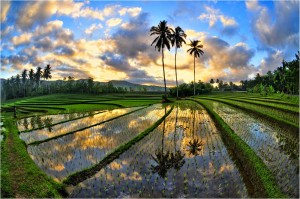 The word “subak” was originally found in Kediri-East Java a Hindu Kingdom in 14th century and then brought to Bali by the Hinduism when this Kingdom was conquered by the Moslem and kept until nowadays.
The word “subak” was originally found in Kediri-East Java a Hindu Kingdom in 14th century and then brought to Bali by the Hinduism when this Kingdom was conquered by the Moslem and kept until nowadays.Subak is an organization of farmers in an area where rice fields are located to manage water to irrigate their rice fields, includes water supply, and to build a temple.
The temple (=pura in local language) is called Pura Subak. Every month the subak members will come together in the temple to discuss matters concerning the subak, water supply, the harvest and the celebration of the anniversary day of the subak temple. They worship Dewi Sri, the rice Goddess.
One big dam can be shared by many subaks. The member of subaks depends on how large the water supplies are. The subak regulates the rice planting and the distribution of water needed by the rice field, to maintain the dam and irrigation canals. The good condition of the dam, the canals and the ditches assure the steady flow of the water to the rice fields and that no water will be wasted.
The “ kelian subak” the head of subak who elected by the members in democratic way has to decide which part of subak who plants rice and which part has to plant the other crops such as : corn, potato, soybean etc due to water condition.
Bali has four lakes, they are: Batur, Bratan, Buyan and Tamblingan from where the water flows especially to the south part of the island: Tabanan, Badung, Gianyar, Klungkung, and Bangli regencies. While the north and east part are dry, they are: Buleleng and Karangasem regions. There are thousands of subaks in Bali.
One of the tourist attractions in Bali is the rice terrace. The beauty of rice terraces is caused by Subak organization who attracts the members to have terracing from mountain, as high as possible as long as the water is there. On dry soil they plants corns, sweet potatoes, peanuts, beans, and other plants that need not much water. To keep the top soil on its place terraced rice field have artistically carved lines as dikes that enhance the beauty of country side.
Periodically, usually every 5 or 10 years after a good harvest, subak of the district organizes a “ Nusaba Nini” a big celebration or thanks giving that usually lasts for at least three days, takes place in a Pura Bale Agung, a village temple with a large and long “ bale”, a building of wood. They decorate granaries and invite the Goddess of all subak temples and rice Goddess of all farmers to be in Bale Agung and stay there for the duration of the festival. It will be a parade with colorful symbols, dresses and offerings in the village. You can also find a “Subak Museum” located in Tabanan regency. Subak Museum keeps any kind of utensils relationship with activities of farmer in Bali. In this place you can learn how and why the “Subak” organization is very important in Bali.
